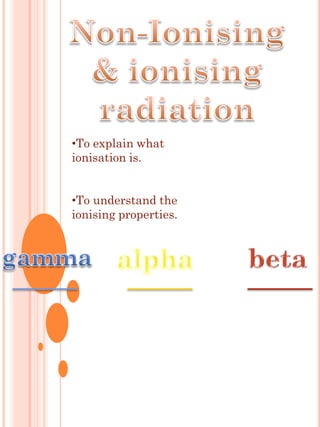Science alpha beta gamma
•Descargar como PPTX, PDF•
4 recomendaciones•3,237 vistas
I did this while I was doing my science research hope its what you were looking for @sara129
Denunciar
Compartir
Denunciar
Compartir

Recomendados
Más contenido relacionado
La actualidad más candente
La actualidad más candente (20)
Atomic number, Mass number, Relative atomic mass and Atomic mass unit

Atomic number, Mass number, Relative atomic mass and Atomic mass unit
Destacado
Destacado (18)
Alpha decay - physical background and practical applications

Alpha decay - physical background and practical applications
Similar a Science alpha beta gamma
Similar a Science alpha beta gamma (20)
Último
Último (20)
Basic Civil Engineering first year Notes- Chapter 4 Building.pptx

Basic Civil Engineering first year Notes- Chapter 4 Building.pptx
Measures of Dispersion and Variability: Range, QD, AD and SD

Measures of Dispersion and Variability: Range, QD, AD and SD
ICT Role in 21st Century Education & its Challenges.pptx

ICT Role in 21st Century Education & its Challenges.pptx
Asian American Pacific Islander Month DDSD 2024.pptx

Asian American Pacific Islander Month DDSD 2024.pptx
Mixin Classes in Odoo 17 How to Extend Models Using Mixin Classes

Mixin Classes in Odoo 17 How to Extend Models Using Mixin Classes
This PowerPoint helps students to consider the concept of infinity.

This PowerPoint helps students to consider the concept of infinity.
Presentation by Andreas Schleicher Tackling the School Absenteeism Crisis 30 ...

Presentation by Andreas Schleicher Tackling the School Absenteeism Crisis 30 ...
On National Teacher Day, meet the 2024-25 Kenan Fellows

On National Teacher Day, meet the 2024-25 Kenan Fellows
Science alpha beta gamma
- 1. •To explain what ionisation is. •To understand the ionising properties.
- 2. WHAT IS IONISATION Ionisation has abilities that allow it to change a atom or a molecule (beta, gamma & alpha) into a ionising material. There are some cases where we are likely to find non ionising radiation (only in some objects for e.g.-) Ionizing radiation can consist of high speed subatomic (means smaller than or occurring with in an atom.)
- 3. It consists of 2 protons (+) 2 neutron s (-) Properties of alpha •Alpha particles are relatively slow. •They have a low penetrating power •You can stop them with just a sheet of paper. Alpha particles are •Alpha Particles relatively slow and heavy are heavier they are not much of a threat to the human body as it penetrates low power. As you can see here alpha is stopped by a sheet of paper
- 4. Beta is a free electron It also consists of fast moving Properties of Beta electrons • A positively charged beta particle differs from an electron by having equal but opposite electrical properties. A stream of beta particles is called a beta ray. •Beta rays are used in equipment for measuring and controlling the thickness of plastic films. •beta has the medium penetrating power and the medium ionising •Beta can be stopped by aluminium.
- 5. Gamma consists of a very high Properties of Gamma electromagne tic radiation. •Gamma waves are what scientists use to keep food longer. •Gamma can cause cancer •It can be an advantage for us however it can also be a disadvantage in terms of the effects it has on us. •They give out a high amount of energy it is extremely dangerous. •it can be stopped by lead.
- 6. DIFFERENCE BETWEEN ALPHA BETA AND GAMMA Demonstrate an understanding of the differences between alpha, beta and gamma radiation in terms of their ability. Alpha particle ionised more gas molecule in the cloud chamber than beta particles, producing more alcohol and water. A gamma ray is a packet of electromagnetic energy. Alpha, beta and gamma are all different (they are all ionising) however this is the only similarity that they differ.
- 7. DEMONSTRATE AN UNDERSTANDING THAT THE FOLLOWING ARE NON-IONISING Visible light Infar red Microwaves Radio waves I can demonstrate an understanding that the following at the top are non-ionising simply because they are all low energy waves that do not consist enough energy to knock of an electron.
